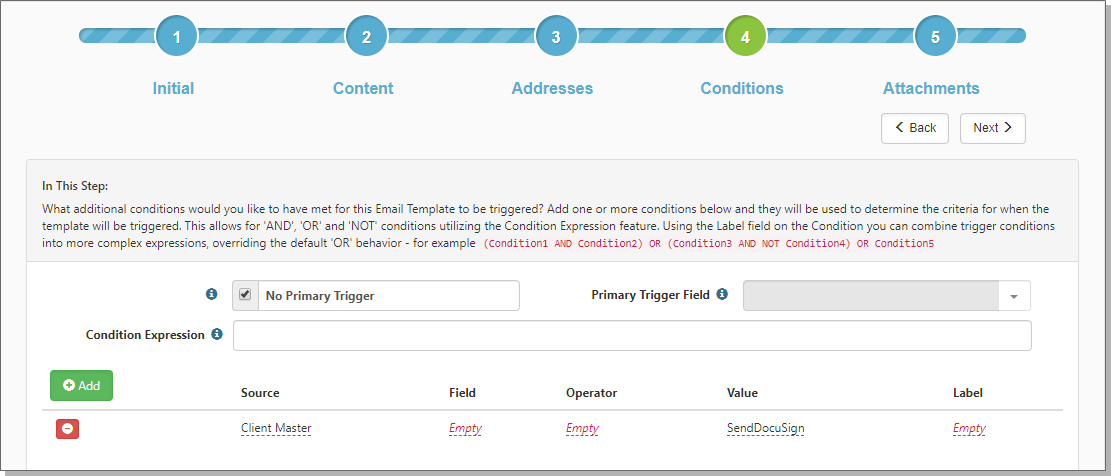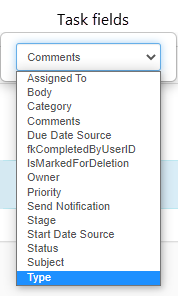Conditions are display conditions and can also include Condition Expressions. Condition Expressions use the labels that you define for your Display Conditions. For a detailed explanation about conditions, see Condition Expressions.
To configure conditions:
- Complete the fields:
| No Primary Trigger | When selected, no single condition must be met to trigger the email template. When selected, the Primary Trigger Field is disabled. | ||||||||||||
|
Only Trigger Once |
When selected, the email template is triggered only once when the conditions are first met. Do not select this option if you want the email template to trigger each time the conditions are met. |
||||||||||||
|
Primary Trigger Field |
Optional. From the Triggering Form selected in Step 1, which, when changed, triggers the event. This can also be a HdrAction, such as a configured action link on the form.
The following statements refer to the condition entries in the Add area. Condition entries are identified with a Label (the last column).
The Primary Trigger Field only displays fields associated with the triggering dataform and includes the ability to Add Untriggered Field. |
To add display conditions:
- Click Add.
A row opens with columns Source, Field, Operator, Value, and Label. The Add section is where you can add more granular triggering conditions. Each row you add is a display condition. When Condition Expression is empty, the display conditions process as ORs, meaning only one of the conditions must be met for the email notification to trigger.
| Source |
The Source list includes the triggering form and its tabs, the channel trigger (i.e., the original form that started the channel), all triggerable, active single-forms, and the tabs of those single-forms. Applicable server data procs, if configured, may also be included.
When you select Task as the Triggering Form in Step 1 Initial, in this step Source sets to Task. |
| Field |
Select the dataform or Stored Procedure field to compare to the trigger value. A few notes:
To add a trigger field:
|
| Operator |
Choose the type of comparison. Each value from a Multi Lookup Trigger Field can be added as a separate "=" condition. This supports complex AND, OR, and NOT conditions as well. Note:
|
| Value | The criteria against which the trigger field is compared. For a condition that is using a user datatype as the Field, the Value field uses a typeahead method so that you do not need to look up the User ID for the text field. |
| Label |
The label to use when constructing Condition Expressions for triggering. ClientSpace assigns a label to a new condition with the naming convention C#. For example, C1 for the first condition that you create, C2 for the second, and so on. You can change the label name by selecting the name of the label and typing a new name for the label. For example, you can select the C1 label and enter Condition1 as the new label name. Tip: Make this label short and representative of the Trigger Field. Labels are used in the Condition Expression field. |
|
Condition Expression |
Allows for AND, OR, and NOT conditions using the trigger conditions (Label) from the Add section. Using the Label field that corresponds to the entries in the Add section, you can combine the conditions into more complex expressions. The Condition Expression field could state, for example (Condition1 AND Condition2) OR (Condition3 AND Condition4) OR Condition5. Condition Expressions adhere to AND/OR/NOT across tabbed dataform conditions. For a detailed explanation about conditions, see Condition expressions. When the Condition Expression field is empty, the row entries are treated as OR conditions. Only one of the conditions must be met. |
To clone a trigger condition:
To save some time, you can clone a trigger condition and then edit as appropriate.
- In the Add section, locate an entry that you want to copy.
- Click
 Clone.
Clone.
A new row opens, with the trigger condition copied. Source, Field, and Operator are copied. - You can now edit the new condition as appropriate.
- Click Apply or Save.
- Click Next to proceed to Step 5: Attachments.


